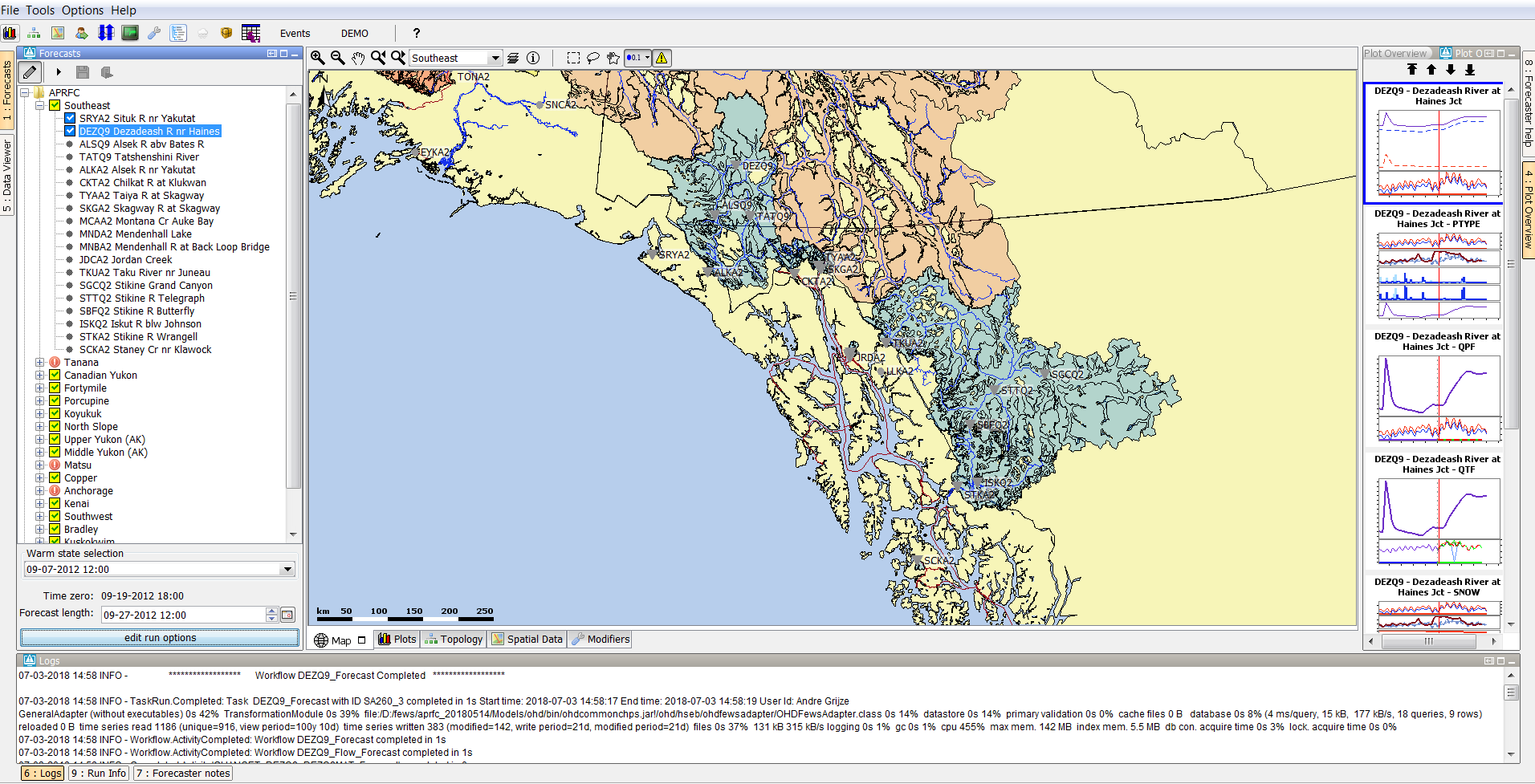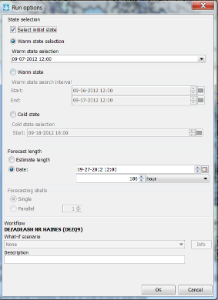...
| Table of Contents | ||||
|---|---|---|---|---|
|
Which displays are used in the IFD?
...
Below is a list of all possible steps in creating a forecast with the IFD.
Please note that not all of the listed steps are required, some steps might not be available/configured in your system.
| Table of Contents | ||||
|---|---|---|---|---|
|
- Start Delft-FEWS
- Selecting the forecast panel
- Reviewing the topology
- Review the list of available state date/times
- Adjust state and/or forecast length
- Starting the forecast process and selecting the workflow for which the forecast should be made
- Reviewing workflow status
- Reviewing graphs (graph display listens to topology selection)
- Reviewing graphs (graph display is independent from topology selection)
- Continue with the forecast process downstream
- Ending the forecast process
Starting Delft-FEWS
After starting Delft-FEWS, the Map display will be displayed in the centre center and the Forecast Panel-tab at the left will be selected.
This the default layout. The layout after starting Delft-FEWS is however configurable by creating and saving a custom layout by , which can be changed to your own layout by using the option File > Save layout in the File top menu.
It is not possible to create modifiers in a synchronization client until the local datastore is fully synched with the central database.
To indicate that the IFD is doing its initial synchronization after startup the forecast-button shows a hour glass icon .
(see image on the right).
While the Operator Client if synchronizing, it is already possible to view scalar and spatial data.
When the initial synchronization is finished the icon will change to a pencil icon to indicate that it is possible to create modifiers.
Selecting the forecast panel
The whole process of creating a forecast by using the IFD is managed by the forecast panel, therefore the first step is selecting the Forecast tab at the left of the display.
The Forecast tab will give an list, typically in computational order of the basins of the region.
Review the list of available state date/times
The forecast panel also shows at the bottom the currently selected (default) warm state.
By clicking on the drop-down box all the available warm states are shown.
If the forecaster needs to use a different warm state than the default, a new warm state date may be selected from drop down menu titled Warm State Selection. If the default warm state is not correct another warm state can be selected from the drop-down box.
The selected warm state represents the The selected warm state represents the end of the period the warm state is searched in. The warm
By default the warm state search period begins a a day before the end of the search period . This is by defaultperiod.
While running a workflowworkflow, the warm state search period period is logged in the log panel.
An example:If t0
- t0 = 26-06-2021 20:00:00 and
- Warm state selection = 25-06-2021 20:00:00
...
- , results in
- search period
...
- logged
...
- :
...
- "Warm state selection -2 day to -1 day, 1 day"
Please noteNote: if when the warm state search period cannot be rounded to to whole days, the period is logged in hours, for example:If t0
- t0 = 26-06-2021 22:00:00 and
- Warm state selection = 25-06-2021 20:00:00
...
- , results in
- search period
...
- logged:
...
- "Warm state selection -50 hour to -26 hour, 1 day"
Adjust state and/or forecast length
By pressing the The "Edit Run Options" button at the bottom of the forecast dialog the user will have gives access to alternative ways of selecting states. After pressing the advanced button
It opens a dialog will be shown in which the user can select the state, forecast length and a what-if scenario.
After selecting the OK-button the selected task properties will be applied and used in the runs.
Starting the forecast process
To start the interactive forecast process, the user should select a local run node and run the workflow of that node.
Reviewing run status workflow
The icons in the forecast tree indicate the status of the workflow of a node.
- A refresh-icon indicate that a workflow is running.
- An hourglass indicates that a workflow is scheduled to run.
More details about the icons can be found in in 24 Topology
Review graphs (graph display listens to segment selection)
When a run has finished the results of the run should can be reviewed . By selecting the using the plot overview display (typically positioned at the right a list of thumbnails will be displayed. ).
For each graph available for the current node a thumbnail will be shown. To display a graph, the forecaster selects a thumbnail and then this graph is displayed Select a thumbnail top open it in the main plot window. The plot display will show the selected graph. The
The Plot Overview panel can be undocked or resized. When the display is expanded resized the plots are automatically resizedfollow suit.
Creating a mod in the time series display
Mods can be created in the mods display or directly in the plot display.
To modify a time series directly in a plot, a time series has to be selected.
This can be done by selecting a time series in the legend of the plot.
Creating a mod in the mods display
The modifier display can be started by clicking on the wrench-icon at the toolbar or by using the shortcut ctrl+m. The modifier display will show all the mods which are applied in the currently selected segment. By clicking on the create mod-button a new mod can be created. After pressing the create mod-button a list of available mods will be shown. When the mod is created it can be applied by pressing the apply-button. With the run-buttons (rerun, rerun to selected and rerun all to selected) it is possible to rerun the workflows. Pressing the run-buttons will also automatically apply the mod.
Continue with the forecast process downstream
After reviewing the graphs and if needed applying mods the forecaster can proceed to the next segment.
Ending the forecast process
When the forecaster thinks that the current forecast is sufficient. The forecast can select the parent node of the leaf nodes and press the 'run on server'-button. When this button is pressed, first all the new modifiers and changes to the existing modifiers of the child nodes of the selected node will be uploaded to the server. When the upload is successful the workflow will be run at the server. The locally created runs will be deleted when the server run was successful and the results are downloaded successfully back to the Operator Client.
...




